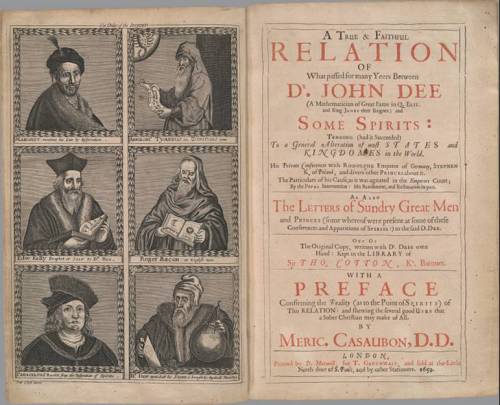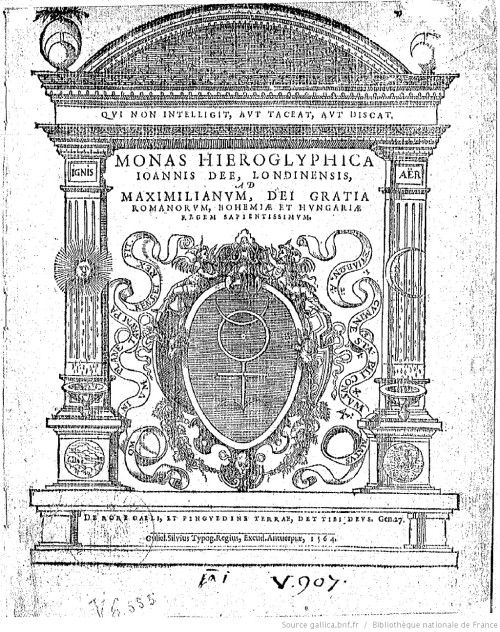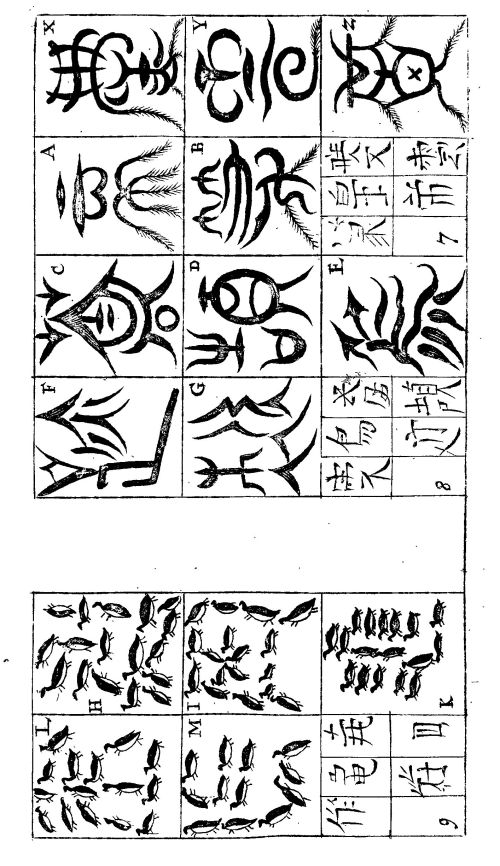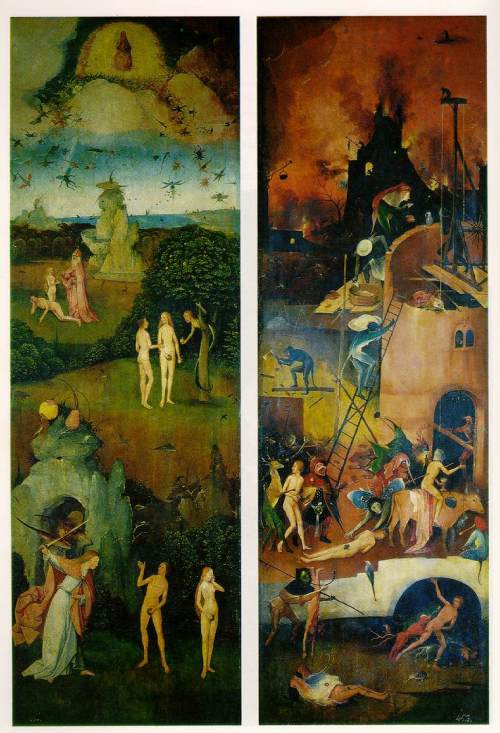Eco: Dee’s Magic Language

Florence Estienne Méric Casaubon (1599-1671), A True and Faithful Relation of what Passed for Many Yeers between Dr. John Dee [ . . . ] and Some Spirits, London, 1659. This work is in the public domain in its country of origin and other countries and areas where the copyright term is the author’s life plus 100 years or less.
“In his Apologia compendiaria (1615) Fludd noted that the Rosicrucian brothers practiced that type of kabbalistic magic that enabled them to summon angels. This is reminiscent of the steganography of Trithemius. Yet it is no less reminiscent of the necromancy of John Dee, a man whom many authors considered the true inspirer of Rosicrucian spirituality.
In the course of one of the angelic colloquies recorded in A True and Faithful Relation of what Passed for Many Yeers between Dr. John Dee [ . . . ] and Some Spirits (1659: 92), Dee found himself in the presence of the Archangel Gabriel, who wished to reveal to him something about the nature of holy language.
When questioned, however, Gabriel simply repeated the information that the Hebrew of Adam, the language in which “every word signifieth the quiddity of the substance,” was also the primal language–a notion which, in the Renaissance, was hardly a revelation.
After this, in fact, the text continues, for page after page, to expatiate on the relations between the names of angels, numbers and secrets of the universe–to provide, in short, another example of the pseudo-Hebraic formulae which were the stock in trade of the Renaissance magus.
Yet it is perhaps significant that the 1659 Relation was published by Meric Casaubon, who was later accused of partially retrieving and editing Dee’s documents with the intention of discrediting him.
There is nothing, of course, surprising in the notion that a Renaissance magus invoked spirits; yet, in the case of John Dee, when he gave us an instance of cipher, or mystic language, he used other means.
In 1564, John Dee wrote the work upon which his contemporary fame rested–Monas hieroglyphica, where he speaks of a geometrical alphabet with no connection to Hebrew. It should be remembered that Dee, in his extraordinary library, had many of Lull’s manuscripts, and that many of his kabbalistic experiments with Hebrew characters in fact recall Lull’s use of letters in his art of combination (French 1972: 49ff).
Dee’s Monas is commonly considered a work of alchemy. Despite this, the network of alchemical references with which the book is filled seems rather intended to fulfill a larger purpose–that of explicating the cosmic implications deriving from Dee’s fundamental symbol, the Monad, based upon circles and straight lines, all generated from a single point.

John Dee (1527-1609), Monas hieroglyphica, 1564, held in the Bibliothèque nationale de France. The Monad is the symbol at the heart of the illustration labeled Figure 8.1 in Eco’s The Search for the Perfect Language, Oxford, 1995, p. 186.
In this symbol (see figure 8.1), the main circle represented the sun that revolves around its central point, the earth, and in its upper part was intersected by a semi-circle representing the moon.
Both sun and moon were supported on an inverted cross which represented both the ternary principle–two straight lines which intersect plus their point of intersection–and the quaternary principle–the four right angles formed at the intersections of the two lines.
The sum of the ternary and quaternary principles constituted a further seven-fold principle, and Dee goes even on to squeeze an eight-fold principle from the diagram.
By adding the first four integers together, he also derives a ten-fold principle. By such a manipulatory vertigo Dee then derives the four composite elements (heat and cold, wet and dry) as well as other astrological revelations.
From here, through 24 theorems, Dee makes his image undergo a variety of rotations, decompositions, inversions and permutations, as if it were drawing anagrams from a series of Hebrew letters.
Sometimes he considers only the initial aspects of his figure, sometimes the final one, sometimes making numerological analyses, submitting his symbol to the kabbalistic techniques of notariqon, gematria, and temurah.
As a consequence, the Monas should permit–as happens with every numerological speculation–the revelation of the whole of the cosmic mysteries.
However, the Monad also generates alphabetic letters. Dee was emphatic about this in the letter of dedication with which he introduced his book. Here he asked all “grammarians” to recognize that his work “would explain the form of the letters, their position and place in the alphabetical order, and the relations between them, along with their numerological values, and many other things concerning the primary Alphabet of the three languages.”
This final reference to “the three languages” reminds us of Postel (whom Dee met personally) and of the Collège des Trois Langues at which Postel was professor. In fact, Postel, to prove that Hebrew was the primal language in his 1553 De originibus, had observed that every “demonstration of the world” comes from point, line and triangle, and that sounds themselves could be reduced to geometry.
In his De Foenicum literis, he further argued that the invention of the alphabet was almost contemporary with the spread of language (on this point see many later kabbalistic speculations over the origins of language, such as Thomas Bang, Caelum orientis, 1657: 10).
What Dee seems to have done is to take the geometrical argument to its logical conclusion. He announced in his dedicatory letter that “this alphabetic literature contains great mysteries,” continuing that “the first Mystic letters of Hebrews, Greeks, and Romans were formed by God and transmitted to mortals [ . . . ] so that all the signs used to represent them were produced by points, straight lines, and circumferences of circles arranged by an art most marvelous and wise.”
When he writes a eulogy of the geometrical properties of the Hebrew Yod, one is tempted to think of the Dantesque I; when he attempts to discover a generative matrix from which language could be derived, one thinks of the Lullian Ars.
Dee celebrates his procedure for generating letters as a “true Kabbalah [ . . . ] more divine than grammar itself.”
These points have been recently developed by Clulee (1988: 77-116), who argues that the Monas should be seen as presenting a system of writing, governed by strict rules, in which each character is associated with a thing.
In this sense, the language of Monas is superior to the kabbala, for the kabbala aims at the interpretation of things only as they are said (or written) in language, whereas the Monas aims directly at the interpretation of things as they are in themselves. Thanks to its universality, moreover, Dee can claim that his language invents or restores the language of Adam.
According to Clulee, Dee’s graphic analysis of the alphabet was suggested by the practice of Renaissance artists of designing alphabetical letters using the compass and set-square.
Thus Dee could have thought of a unique and simple device for generating both concepts and all the alphabets of the world.
Neither traditional grammarians nor kabbalists were able to explain the form of letters and their position within the alphabet; they were unable to discover the origins of signs and characters, and for this reason they were uncapable (sic) to retrieve that universal grammar that stood at the bases of Hebrew, Greek and Latin.
According to Clulee, what Dee seems to have discovered was an idea of language “as a vast, symbolic system through which meanings might be generated by the manipulation of symbols” (1988: 95).
Such an interpretation seems to be confirmed by an author absent from all the bibliographies (appearing, to the best of my knowledge, only in Leibniz’s Epistolica de historia etymologica dissertatio of 1717, which discusses him in some depth).
This author is Johannes Petrus Ericus, who, 1697, published his Anthropoglottogonia sive linguae humanae genesis, in which he tried to demonstrate that all languages, Hebrew included, were derived from Greek.
In 1686, however, he had also published a Principium philologicum in quo vocum, signorum et punctorum tum et literarum massime ac numerorum origo. Here he specifically cited Dee’s Monas Hieroglyphica to derive from that matrix the letters of all alphabets (still giving precedence to Greek) as well as all number systems.
Through a set of extremely complex procedures, Ericus broke down the first signs of the Zodiac to reconstruct them into Dee’s Monad; he assumed that Adam had named each animal by a name that reproduced the sounds that that each emitted; then he elaborated a rather credible phonological theory identifying classes of letters such as “per sibilatione per dentes,” “per tremulatione labrorum,” “per compressione labrorum,” “per contractione palati,” “per respiratione per nares.”
Ericus concluded that Adam used vowels for the names of the beasts of the fields, and mutes for the fish. This rather elementary phonetics also enabled Ericus to deduce the seven notes of the musical scale as well as the seven letters which designate them–these letters being the basic elements of the Monas.
Finally, he demonstrated how by rotating this figure, forming, as it were, visual anagrams, the letters of all other alphabets could be derived.
Thus the magic language of the Rosicrucians (if they existed, and if they were influenced by Dee) could have been a matrix able to generate–at least alphabetically–all languages, and, therefore, all the wisdom of the world.
Such a language would have been more than a universal grammar: it would have been a grammar without syntactic structures, or, as Demonet (1992: 404) suggests, a “grammar without words,” a silent communication, close to the language of angels, or similar to Kircher’s conception of hieroglyphs.
Thus, once again, this perfect language would be based upon a sort of communicative short-circuit, capable of revealing everything, but only if it remained initiatically secret.”
Umberto Eco, The Search for the Perfect Language, translated by James Fentress, Blackwell. Oxford, 1995, pp. 185-90.


